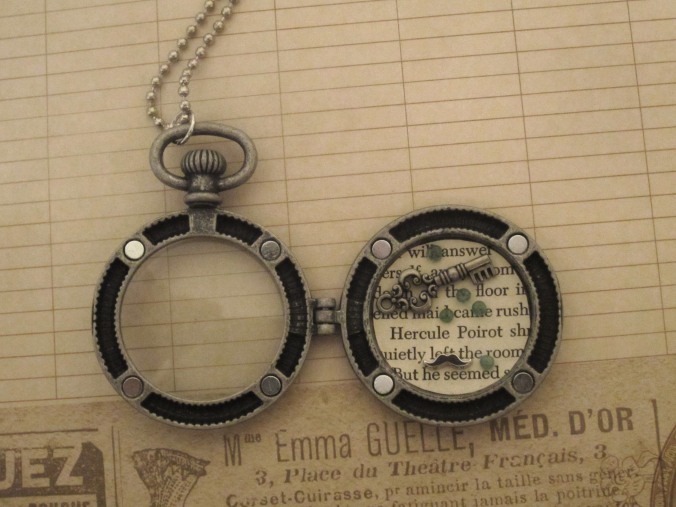I am thirty-six times an idiot for not sharing photos of the cast party favors I’d made for Murder on the Orient Express!
I created a rectangular piece out of clay with train tracks and the title of the play, made a mold out of it, and made chocolates that I accented with edible paints and lustre dust. There are also cookies with mustache-embossed fondant. All packed in cute little suitcase boxes with train charms. ❤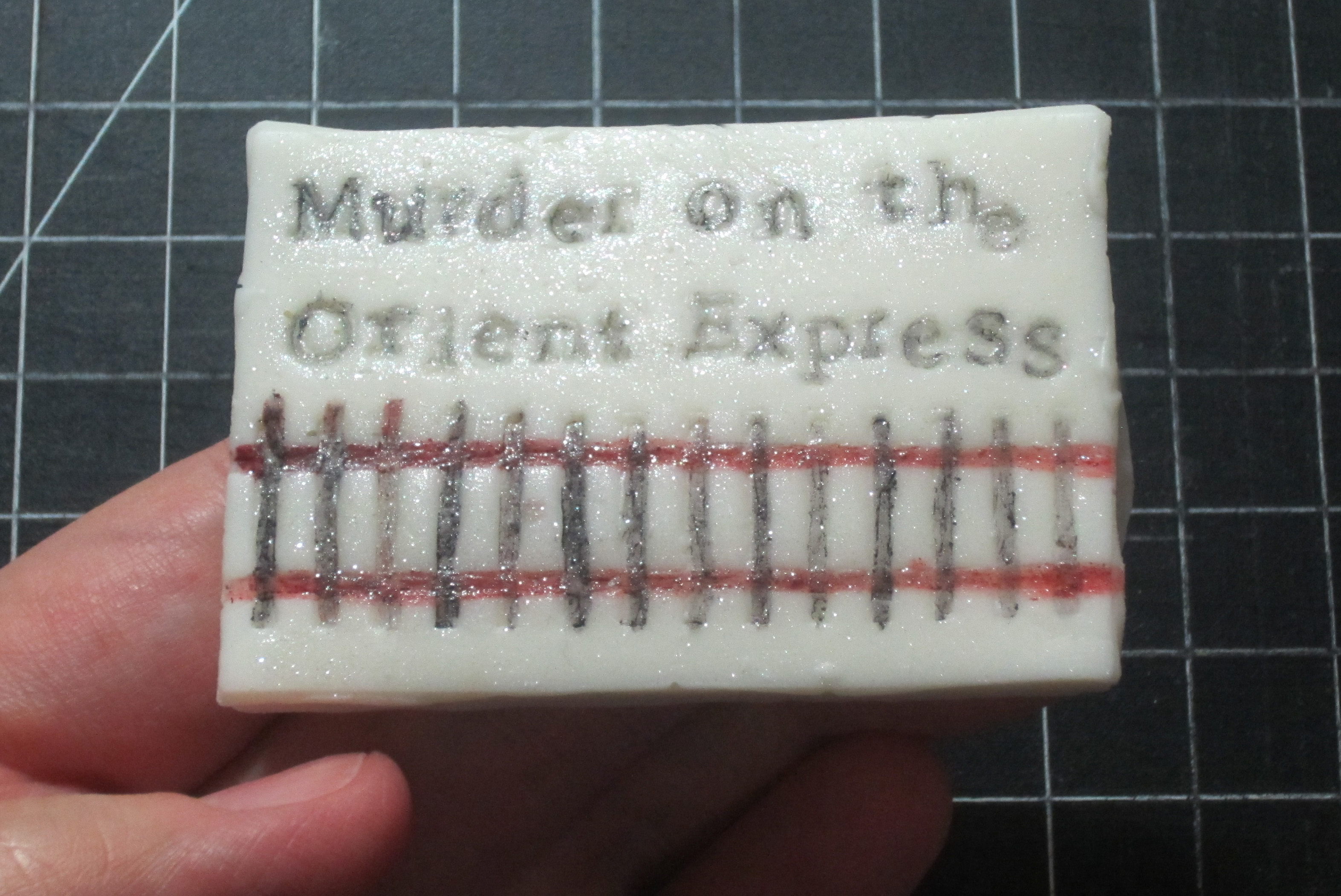
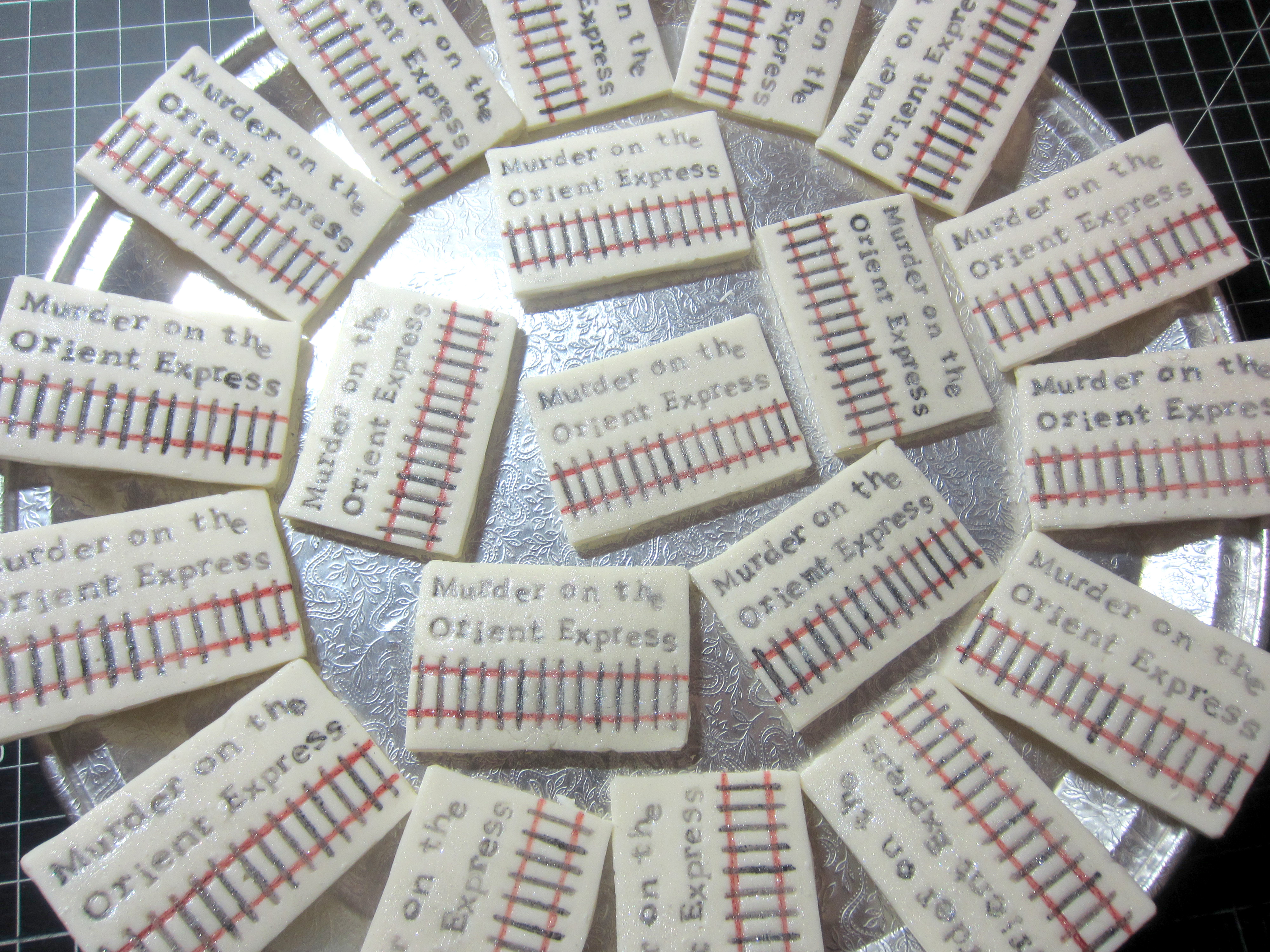
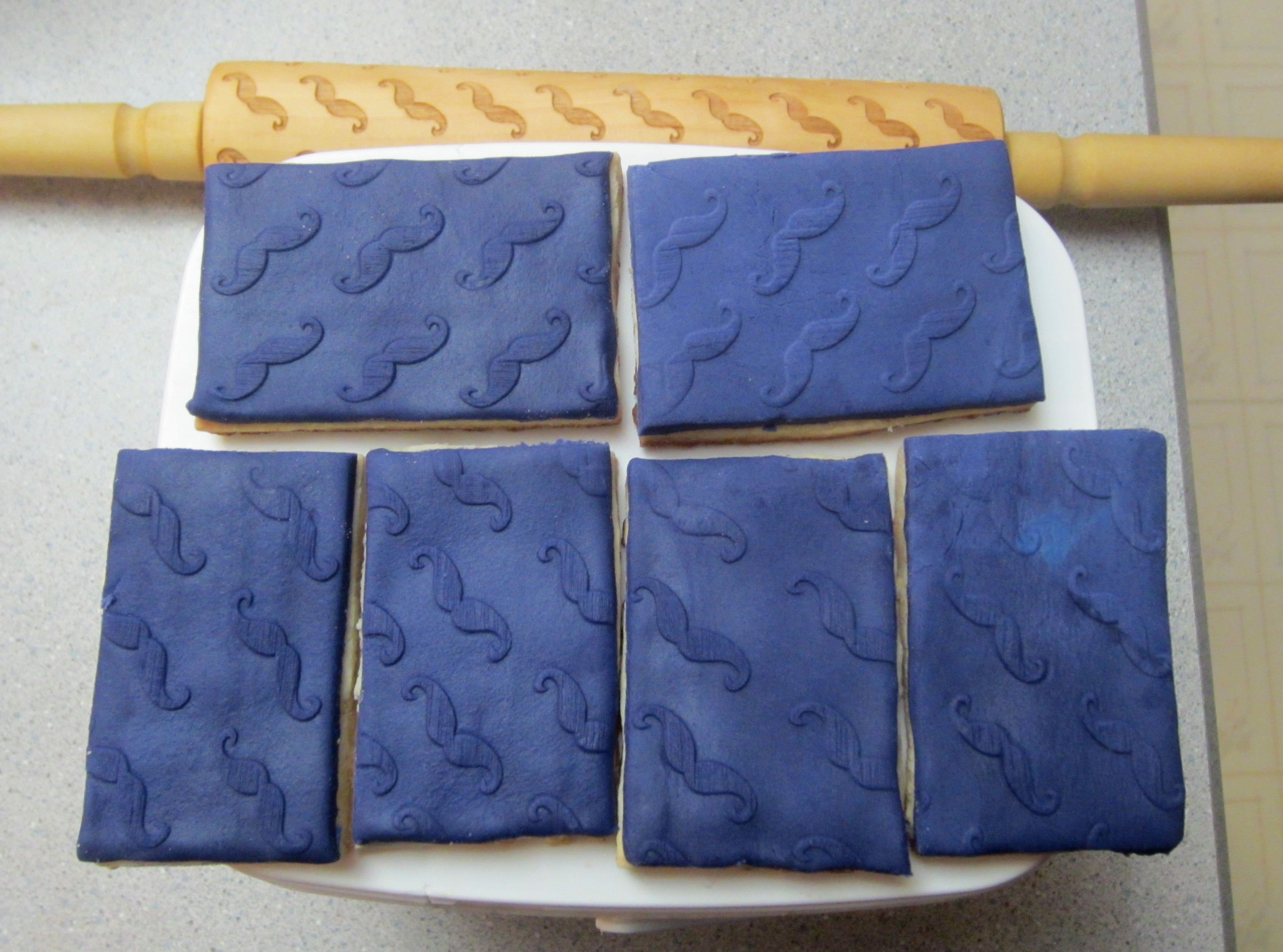
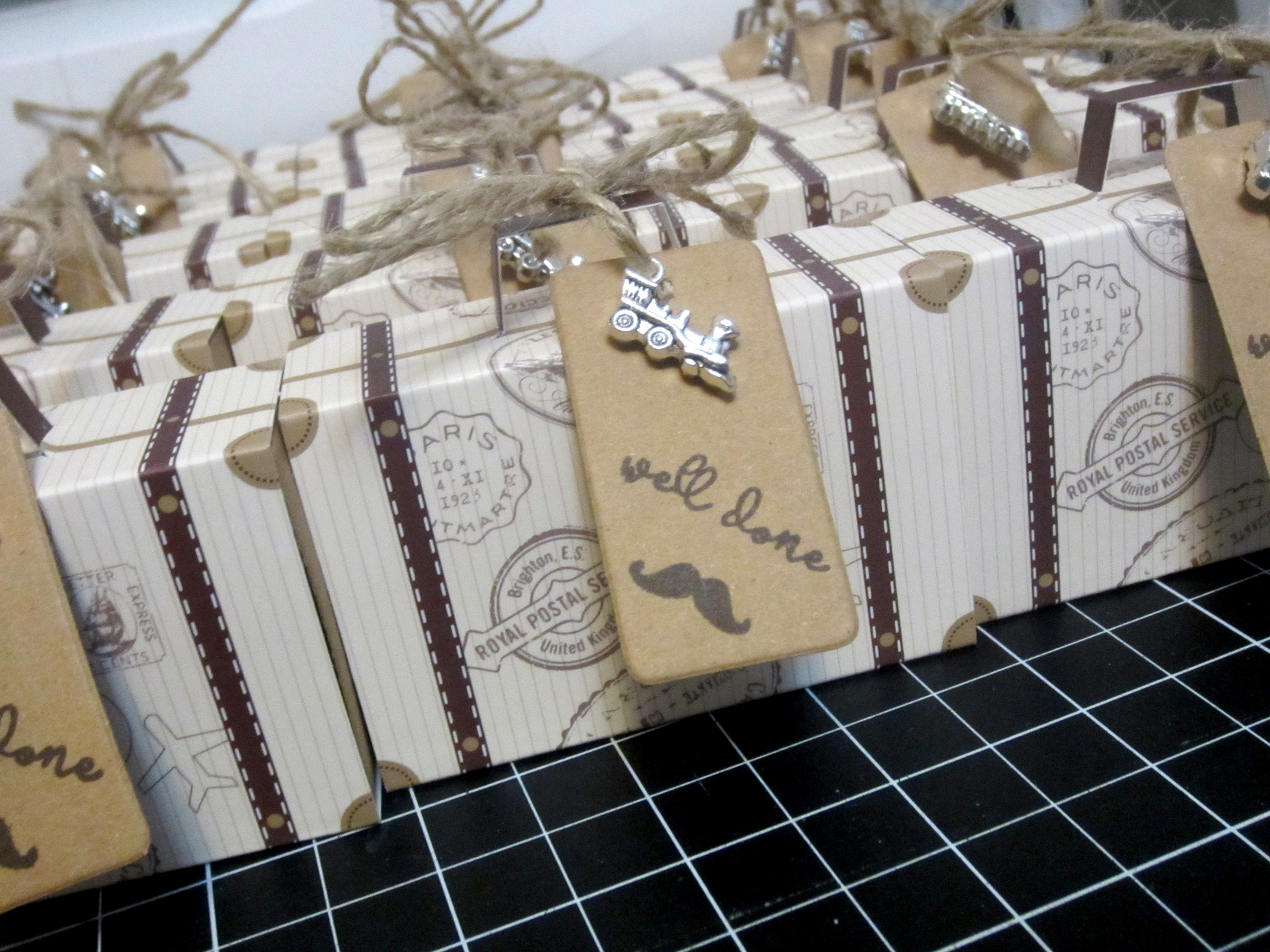
moustache
POIROT – A Celebration of Style
The Ultimate Fashion History, a YouTube channel hosted by Amanda Hallay, has recently published a delightful half-hour video on the series Agatha Christie’s Poirot. It’s a fascinating look at the fashion and style choices of the series, and how individual characters are made unique through the distinctives of their aesthetic. Definitely check it out!!! (Screen shots below from the YouTube episode.)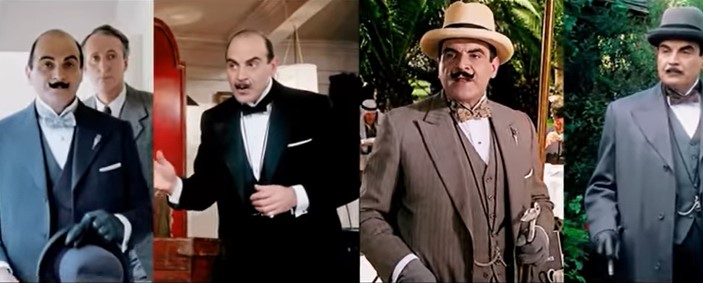
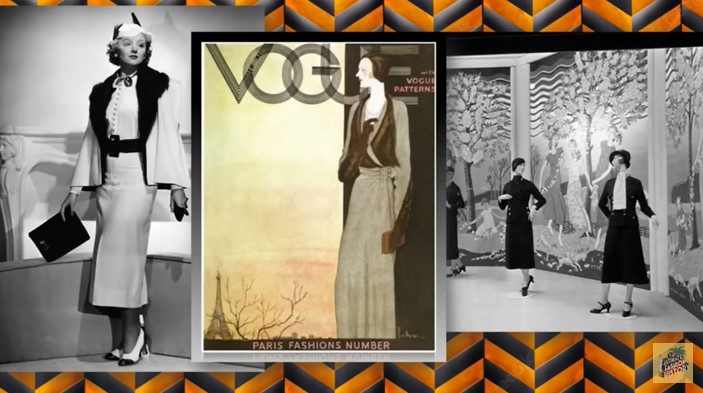
Poirot-themed marzipan
Poirot Gourmet: Quiche Lorraine with “Le Sneak Belgique”
We found this local (Winnipeg-based) Belgian-style beer the other day. It’s called Le Sneak Belgique, a witbier made with coriander, orange peel, and black pepper. Did I mention that the can is adorned with a moustache?? 🙂
I had to bring it home and feature it in a blog episode of Poirot Gourmet. So I decided to pair it with miniature versions of Quiche Lorraine and a side salad with tomatoes, walnuts, balsamic vinegar and black truffle olive oil. 🙂 Lovely comfort food for autumn!
Fashion Week, Day 6: Accessories
Day #6: Accessories
“Kelly,” you say, “it’s all very well for a maniac like you to have Poirot-inspired stuff in your closet. But I don’t want to go to that level of weird. What if I just want an accessory or two to hint at my Agatha Christie fangirl-ness?”
Fine– here are some options for you. 🙂
An awesome moustachioed wallet, for example…
A famous designer recently created a line of handbags that look like vintage Christie books. Unfortunately I don’t even remember who that was or even anything about it, other than the fact that they were infinitely more than I could afford. But apparently people at Etsy like making purses and clutches out of Christie books, too.
How about nail art? Here are some stickers– I like these ones because they include some hats and bow ties along with the moustaches. Tiny 3D moustaches are also available out there for the nails.
Here’s a little barrette I custom-made using some awesome cabochons I found in some craft store. A silver version of the same barrette was a blog giveaway prize last year. 🙂
Finally, the jewellery. I make quite a bit of jewellery– no, not just Poirot-themed stuff– but every now and then…
Pocket watches are a favorite Poirot design element of mine for jewellery. They come as charms or as full-sized pieces, including pendants that function as little customizable shadowboxes. ❤
The pendants below were personalized using pages of vintage Christie books.
I love tiny magnifying glasses. The magnifier pendant above works nicely on a bit of transparent line, so that it appears to be “mysteriously” suspended on thin air. 🙂
This moustache bracelet was given to me for Christmas this year by a sister-in-law.
A few Halloweens ago, I decided to go Poirot-themed. Along with the pocket watch necklace and a pinned flower on the lapel of a blazer, I opted for an ear cuff with a chain. It was a little bit punk, and in a funny sort of way, it seemed to suggest Poirot’s fob and chain to me. 🙂
One more day left of Fashion Week!
Fashion Week, Day 5: Socks!
Day #5: Socks!
Who doesn’t love fun socks? If you’re going to have socks, you might as well have moustachioed ones. I’ve hunted about for socks with question marks, to be more generally mystery-themed, but question marks are (appropriately enough, I guess) an elusive motif. I’ve also availed myself of other socks by Out of Print that deal with detective fiction– they’ve got splendid Sherlock Holmes and Edgar Allan Poe offerings in their store. But if you want Christie’s Poirot, you must content yourself with the moustache. Happily, moustachioed socks abound.
Here’s my daughter, proudly modeling hers…
I got the moustache socks below from Sock It To Me. It looks like they don’t have these particular ones in stock anymore, but they have a few other moustache options on their site.
Moustache slippers are also easy to find. Etsy is absolutely chock full of options, especially for babies, boys, and men. Here are a few photos of what an Etsy search can do for you; with a bit of luck, you can find Poirot-esque elements that pair with the moustache, like a vintage hat. 🙂
A figure was standing on the stairs a little way above them. It moved down and into their range of vision.
They stood staring at the little man with a very fierce moustache and an egg-shaped head. He wore a resplendent dressing gown and embroidered slippers.
-“The Third Floor Flat”
Random thoughts on the new Murder on the Orient Express film
***SPOILERS for Murder on the Orient Express and Curtain***
I came into the theatre this evening full of hearty pessimism. This was less to do with consternation at Branagh’s moustache and more to do with the fact that I have never yet seen a screen adaptation of Murder on the Orient Express that didn’t, in some way or another, annoy me greatly. I think the novel is terrific, and the Suchet audiobook is my favorite dramatization of the story. But evidently it’s quite a difficult story to adapt for the screen, and no matter how beautifully shot or how great the actors are, the scripts always make me want to tear my hair out. So it was with the greatest of skepticism that I approached the new film.
My own commentary on the film will be, first and foremost, from my perspective as a Christie fan and reader. There was, I confess, a good deal of wincing and cringing on my part. But there were also a few pleasant surprises. My overall impression was a general and complacent “meh.” Here I will present a stream of random, muddled observations, great and small…
• The film opens in Jerusalem (rather than Syria) with a strangely comic tableau at the Wailing Wall, of all places. Poirot refuses mismatched eggs and then goes on to dramatically hold forth concerning a relic robbery involving, as suspects, a rabbi, a priest, and an imam. It sounded like the start of a bad joke, and it kind of came off as one, too. Here, also, we are introduced to Poirot’s “weaponized” cane, with which he would go on to stop baddies, break open doors, and do heaven knows what else with. *scratches head* The overall effect of this opening is to give the viewer the impression that they’ve signed onto a rather light-hearted romp, which seems to me a weird thing to do for Murder on the Orient Express. The film goes on to get rather muddled in the middle with Poirot’s interviews, finally slowing down to a snail’s pace from the final denouement onward.
• Branagh manages a pleasant sort of French-sounding Belgian accent. Christie is funny on this point; she never describes Poirot as actually sounding Belgian, nor does she mention any familiarity on his part with the Flemish language. The whole effect he presents to others is “French.” Too much Flemish would be a mistake, but I think Branagh manages the accent well.
• Monsieur Bouc, who despite his name does not sound very Belgian or even French, consorts with a prostitute. An elderly man appears in the room and Poirot asks him if he also is a prostitute. WHAT? Poirot is eccentric, but is supposed to be extremely polite. His curious rudeness continues when first meeting MacQueen in the compartment they will initially share.
• When Poirot meets Mary Debenham, who is decidedly more chit-chatty than her book counterpart, he shows off with a few more deductions a la Sherlock Holmes, divining where the girl came from as well as her profession. For me, this is a supreme no-no: you do not make Poirot into another sort of Holmes. Christie’s character is observant, but he doesn’t give his hand away by laying out an acquaintance’s life history at first meeting like Holmes does. They are very different detectives.
• Poirot giggles like a ninny while reading Dickens’ A Tale of Two Cities. I was not impressed at Poirot giggling… and giggling at that particular book? However, I found myself vaguely pleased, as a Christie reader, that Poirot was reading Dickens, because he does. (He actually says so in the book Murder on the Orient Express, which is how he knows that “Mr. Harris” would not show up.) One also wonders if the book wasn’t chosen as foreshadowing in which Poirot is, in a later moment of willing and deception-laden self-sacrifice, supposed to be a sort of parallel of Sydney Carton.
• I actually liked how that famous line about Poirot not liking Ratchett’s face was set up in the script. The line did not appear at all in the 2010 adaptation. Branagh’s Poirot frames the comment in terms of knowing, from long experience, what he does and doesn’t like, and pointing out that he realizes Ratchett is a criminal and therefore does not wish to take his case. In a way, I felt that this made Christie’s original line seem a little less arbitrary.
• Bouc begs Poirot to take on the case, suggesting it will be easy for him to look around, get interviews, establish the passengers’ bona fides, and reach the solution. But in Christie’s novel, the interesting point to Poirot is that it is impossible to determine the passengers’ bona fides on the train, since they’re cut off from everyone in the snowdrift.
• The introduction of racial issues seemed a little too forced in this script. Now, if they had used that later on as commentary on the widely-varying personages and how such a variety could have come together only in America– thus shedding light on the mystery’s solution– that might have worked. But as my memory serves… they didn’t.
• Katherine? Katherine?? What the.
• Apart from anything actually murder-related, everyone’s kind of weirdly violent. The missionary is violent. Arbuthnot is violent. MacQueen is violent. Poirot is violent. Ratchett keeps pointing his gun at people for the fun of it, or something.
• Speaking of the missionary, why oh why is the name of Pilar Estravados lifted out of Hercule Poirot’s Christmas and plopped into Murder on the Orient Express? Is a Spanish nurse thought to be more exotic than a Swedish nurse? Whatever the reason, I will admit to appreciating this role far more than the Greta Ohlsson of the 2010 episode. She came across as unsympathetically smug and was a terrible exegete to boot.
• Likewise, I liked this film’s Mary Debenham much better than the self-righteous, “You must call stabbing a man to death a positive good and right thing or else you’re a mean judgy-head because of my Feels” character of the TV adaptation. Overall, this film’s characters had a lot more humility and were less hell-bent on self-justification at all costs. Like the book, it makes it easier to sympathize with them when the reader (or viewer) is gently shown that people driven crazy by grief can sometimes carry out horrible vengeance. Recognizing this murder as one more terrible tragedy in a long line of terrible tragedies is more effective than the perpetrators screaming at Poirot, in true 21st-century fashion: “Accept what we did as right, you hater!”
• Similarly, let’s talk about Poirot’s “growth” or change as a character. Both the film and the TV adaptation present a Poirot with an extremely simple concept of right and wrong, and by the end he realizes that life is actually complicated. I know that screen versions must differ from books… but it’s just not what I get from the books. There is a reason that so many fans felt that Suchet’s Orient Express contained his least Poirot-like dialogue. Poirot does have a firm moral compass, but he has never been oblivious to human psychology, unsympathetic to suffering, or hitherto unfamiliar with complex situations and murky waters. Strong morality does not equal naivete and it facilitates, rather than impairs, sympathy. What’s more, Christie works in a plethora of special contingencies that do not allow the reader to make such bald, radical statements as: “Poirot just let twelve murderers go free” or “Private vengeance is obviously justified if you feel really strongly in your heart that it’s right.”
• There are a few times that Branagh’s Poirot quotes other Poirot novels. There are two quotes from The Mystery of the Blue Train: “My name is Hercule Poirot and I am probably the greatest detective in the world.” Also, there is a close approximation of: “You tell your lies and you think nobody knows. But there are two people who know. Yes– two people. One is le bon Dieu– and the other is Hercule Poirot.” But perhaps the most interesting quote was lifted from Curtain. Poirot, murmuring to his mysterious Katherine photograph, says: “I have always been so sure– too sure… but now I am very humble and I say like a little child ‘I do not know…’ It’s one of Christie’s most beautiful Poirot quotes, written to Hastings and read after Poirot’s death. My one quibble here is what Poirot means when he speaks to the photograph; I forget where exactly in the film this happens– does he know who the murderers are at this point and is contemplating what would be the right action to take? If so, then the meaning of this quote is ironically the exact opposite of its meaning in Curtain. In that story, Poirot shoots and kills a dangerous man who gets others to murder for him, and is contemplating whether his actions could be considered justified, since he has saved others by the desperate deed. BUT, he is not willing to let himself off the hook so easily. He will not say, with swaggering confidence, that he definitely did what was right. Rather, he has humility– considering the deed, at best, a lesser of two evils– and entrusts himself to God’s mercy. In other words, the book quote is about not being too sure of yourself when you’ve just murdered someone, even someone reprehensible. In the film, the quote is about Poirot not being sure whether or not to take a firm line with people who have just murdered a reprehensible someone. I think I was more upset at the misuse of this quotation than at almost anything else in the film.
• My husband Alex asked me: “Is there anything that Branagh revealed about Poirot’s character from Christie that Suchet hadn’t done?” There was one thing that I noticed and liked a lot– Poirot interviewing the princess’s maid in German. Poirot speaking German, I thought, was great to see. His knowledge of the language helps him solve a clue to a different character’s identity in the film, not unlike Suchet’s Poirot does with the German brother and sister in the episode The Clocks. I love examples of Poirot the linguist.
• Instead of the murder weapon being hidden in the sponge bag quietly and inconspicuously, as would be sensible, Mrs. Hubbard gets stabbed with it instead. In the film, this is solely to try to distract Poirot and throw the blame off the person he is currently interviewing. But is anyone seriously supposed to believe that the murderer would dispose of his weapon by stabbing someone with it…? The moment came across as weird.
• Speaking of Mrs. Hubbard, why does she always seem to get re-written as a vamp instead of as the ridiculous, over-fond mother? In that capacity, she alone could suffice for comedic effect when it’s needed, but recent adaptations (including the 1974 film) don’t use Christie’s own humor here, and I wonder why. Instead, Mrs. Hubbard just comes across as a little cheap. “There was a man in my compartment!” “Are you sure it was a man?” “I know what it feels like to have a man in my room.” Similar lines are used both in 1974 film and in the TV adaptation, and were added into Branagh’s film as well.
• The silly moustache guard… a tribute, I suppose, to Albert Finney’s Poirot. Hmm.
• In general, I was not pleased with Poirot’s deductions. There is not a lot of “fair play” with the audience. Again, it’s more like watching Holmes.
• Okay, time for something else I thought was well done. There is something I was hoping to see in this film version that I thought would be a simple and effective way to pump up the emotional drama, and they did it– Daisy Armstrong flashbacks. Christie does this in her books as well. I can’t be the only person who tears up when reading of how much the members of the Armstrong household loved Daisy and the other Armstrongs. The idea that John (sic) Armstrong had initially written to Poirot for help with the case before he committed suicide in despair was also an interesting addition to the film’s storyline.
• “M. Bouc can lie. I cannot.” Um, sure you can. You’re Poirot, not George Washington. You love lying, in fact. It is an art form with you. I’ve heard it from Hastings himself.
Overall… the film was a pretty strange experience for me. I am not such a Christie purist that I refuse to accept, in dramatizations, any departures from the books at all. Switching between mediums is a tricky business, and I’m sure that much thought and discussion went into the ideas used. All the same, it didn’t click with me. If Christie didn’t write it, it might be okay to use in an adaptation; but if I can’t imagine her having written anything like it, I’m probably not going to approve of this or that choice.
Christie’s physical descriptions of Poirot: Branagh and Suchet
The trailer for the new Murder on the Orient Express film has been released. Various reactions ensued. There’s a lot of excitement, of course, at the prospect of Christie on the big screen again. There’s a heavily star-studded cast (not unlike the 1974 Finney production, in that way). But what stands out to me is the visceral reaction to the simple sight of Kenneth Branagh’s Hercule Poirot. A lot of longtime and hardcore Poirot fans are stunned– not necessarily in a good way. And yeah, okay, I’m one of them. I may have used the phrase “greying, tousled 21st-century hipster” once or twice.
And yet, I do want to be as fair as possible. Fans were bound to react with a great deal of indignation at the sight of another Poirot after Suchet’s 25-year span on the small screen. So utterly dedicated was he to the character, so very convincingly did he pull off the role, that it has become difficult to associate Poirot with anyone else. (Ustinov who?) I don’t think I personally ever really will. He really did seem to just waltz off the written page and onto the screen.
So let’s consider the written page– Christie’s own physical description of Poirot. Many fans are comparing the look of Branagh’s character unfavorably to Christie’s original. Others are comparing only against the Suchet interpretation, and although he’s famously faithful to Christie, there are still distinctives against which, from a more purist point of view, certain criticisms of Branagh would be somewhat unfair. You might say that this post is me trying to put a best construction on, against my own knee-jerk reactions. 🙂
Poirot is described for us, via Christie, as about five feet four inches tall, or “no more than” five foot five. Branagh seems to be somewhere between 5’9″ and 5’10”; Suchet is apparently around 5’7″. Neither actor is quite there, although Suchet is closer.
Christie often describes Poirot’s distinctive green eyes. Branagh’s are blue; Suchet’s are brown. Arguably Branagh is “closer” there. 🙂
But oh! the moustache! What great consternation was caused by Branagh’s eye-popping facial hair– definitely grey, whereas Suchet keeps a proper blackness. But I think what shocked people more was the flamboyance of Branagh’s. Having a big and flamboyant moustache is actually quite in keeping with Christie, as well as with the early 20th-century continental ‘stache in general. She has many ways of describing Poirot’s, so some variation is acceptable for the purist. But she does occasionally use words like “enormous” (e.g. Dead Man’s Folly). I even seem to remember something about the Christie estate expressing surprise at the time that the Suchet ‘stache wasn’t as flamboyant as it could have been, although they understood the reasoning of the creators of the show. And I think the decision about the ‘stache for Suchet, Brian Eastman, etc. really came down to a desire to not make Poirot appear more ridiculous than necessary. It’s true that in the books, the extreme moustache did contribute to many Englishmen’s contempt for Poirot and their view of him as ridiculous. But by the late ’80s, the character of Poirot himself seemed to have become somewhat of a joke– people didn’t take him seriously, which is why John Suchet initially discouraged his brother from taking the role. It became very, very important for the show’s creators, as it was for Christie’s family, that the character be taken seriously, and I do think that the moustaches they had for Suchet’s Poirot were the right choice as a result. Now that Poirot is firmly established on screen as the serious and well-rounded character that he is, thanks to Suchet, another actor can perhaps come along and demonstrate the flamboyancy aspect of it (although identifiable wax and pomade is still most in keeping with the books). And I think that Branagh really had little choice but to differentiate his Poirot from Suchet’s in various ways, for better or worse. So there you go…
A few other words about hair. My own biggest issue with the Branagh image is that in some of these early photos, Poirot’s hair looks too unkempt, and his centre parting goes haywire. It is also too grey, although one might make one small observation that way. Although Christie mentions more than once how “suspiciously” black Poirot’s hair is, and either hints or states outright that he dyes it, consider Hastings quote from The A.B.C. Murders on the subject…
‘You’re looking in fine fettle, Poirot,’ I said. ‘You’ve hardly aged at all. In fact, if it were possible, I should say that you had fewer grey hairs than when I saw you last.’
Hastings goes on to say that Poirot’s hair is “so much blacker” than when he saw him last. The inescapable conclusion, then, is that Hastings has seen Poirot with greying hair! But it’s true, we don’t actually see it on the written page (not until almost the very last page, anyway), so ultimately I come down on the side of grey hair being a no-no. 😉
Since we’re talking about hair, here’s one of my favorite descriptions of Poirot’s appearance from “The Mystery of the Baghdad Chest”:
To see Poirot at a party was a great sight. His faultless evening clothes, the exquisite set of his white tie, the exact symmetry of his hair parting, the sheen of pomade on his hair, and the tortured splendour of his famous moustaches– all combined to paint the perfect picture of an inveterate dandy. It was hard, at these moments, to take the little man seriously.
Poirot is always described by Christie as at least appearing to have a full head of hair, with a centre parting. In the pictures I’ve seen, Branagh’s Poirot just looks too 21st-century for my liking– not enough pomade, and at times downright tousled! So, what are we to make of Suchet’s Poirot on this point? As a matter of fact, a significant number of stage, screen, or artistically-rendered Poirots in days gone by are deliberately depicted with vanishing hairlines, contra Christie. Why? I think the most obvious answer is that, far more prevalent than the author’s description of Poirot’s hair is her famous description of his head— “egg-shaped.” Christie herself, humorously, wasn’t quite sure what an egg-shaped head even was. But since it calls attention to head shape, it automatically (at least to me) creates a visual assumption of some level of baldness.
For the overall effect in appearance, Christie describes Poirot as looking “positively exotic” (e.g. Dumb Witness, etc). Suchet most definitely wins that contest. He has mentioned in interviews that his Eastern European heritage has aided him in playing the roles of “outsiders,” as he “certainly doesn’t look like a typical Englishman.” I don’t really know what a typical Englishman is supposed to look like, but if I had to guess, Branagh (who’s from Northern Ireland) might be high up on my list.
For general body type, Poirot is written as a “small, compact figure” (The Labours of Hercules), “delicately plump” (The Big Four), with “a certain protuberance around his middle” (Evil Under the Sun). Although vain about his brainwork and meticulous about appearing neat, he has no illusions about being attractive to the opposite sex, and in physical appearance is only proud of his moustaches. Other physical descriptions of Poirot from Christie include “expressive eyebrows,” “tiny, fastidiously-groomed hands,” and “short, stubby fingers.” He is in the habit of tilting his head to one side like “an inquisitive robin.” He is attired in correct, well-pressed and symmetrically neat urban wear, has an English tailor (Dumb Witness), prefers his large turnip of a pocket watch, and indulges in bling like pearl studs (“The Under Dog”). Christie’s written character uses no spectacles, monocle, or pince-nez (Lord Edgware Dies). He wears tight patent leather shoes which are a regular source of discomfort for his feet and affect the way he walks. And he always wears a hat when outside and muffles up to the nines against any possible chill.
It will be interesting to see how much, or little, of Christie’s descriptions factor into the appearance of Branagh’s Poirot. I was not favorably impressed by the grey and the generally rumpled appearance he seemed to present. And I’m still thoroughly convinced that Suchet was the perfect Poirot, so much so that in whichever little ways his presentation of the man departs slightly from the books, it seems that Christie herself must have gotten it wrong! That bias of mine has to serve me as a reminder that Branagh, great actor that he is, does deserve at least some leeway.
We’ll see what we shall see…

The 10 most “Poirot” fabrics you’ve EVER seen
I’m a multi-crafter. As quilting is one of my many hobbies, I enjoy hunting for fabrics in unusual themes and motifs that are of interest to me. Poirot has been no exception.
If making Poirot-themed throw quilts is too strange for you (and why should it be? I’m on my fourth or fifth one), perhaps you’ve been thinking of sewing up a tote bag or laptop cover. Why not make one that reminds you of your Agatha Christie interests? 🙂
My criteria for selecting the following fabrics for this post was that each one must represent at least two things that point to Poirot. All fabrics are 100% cotton. I can’t promise that you can necessarily track them all down, but I’ll provide information to help you with your own searching. One or two of these fabrics are somewhat dubious copyright-wise, and one or two aren’t for sale at all. But I hope all will inspire you as fabric-loving Poirot fans. 😉
1.) “Ladies and Gentlemen” fabric by David Textiles
For generic fabric, it hardly gets more Poirot-esque than this black-and-cream fabric. The texts say: “A gentleman is always well-groomed” (moustache), “A gentlman is always well-dressed” (hat and wing collar), “A gentleman is always well-prepared” (umbrella), and “A gentleman is always well-mannered” (hand writing courteous notes). I think you’ll agree that this is Poirot all over! I used this fabric, cut into strips, for my A.B.C. Murders quilt top.
2.) “Longfellow” by Windham Fabrics
I stumbled upon this particular print from the “Longfellow” line while searching for fabric with magnifying glasses (not easy). This one, representing some gentleman-scholar’s desk, features several things suggestive of Poirot: the glass, the pocket watch, old books, maps, and correspondence. The “Longfellow” line also has two other coordinating fabric prints with only pocket watches all over.
3) “Poirot Words” by Kelly Klages (Spoonflower)
I created this fabric– also in black on white– via Spoonflower for personal use (a.k.a., not for sale, sorry). At first glance they are just random French words and expressions, but careful Christie readers know that they are all very Poirot-esque utterances. I used a font reminiscent of that used in the television series. This fabric gets used in just about all of my Poirot projects. 🙂
4.) Moustache batik
I have no information on this multi-color batik fabric, but I was genuinely astonished at how POIROT it was. Many such moustache prints will throw in a motif or two that is not suggestive of our favourite Belgian, such as a pipe or hipster glasses. But this fabric stays so Poirot that you wonder if they didn’t actually have him in mind when designing it.
5.) “Murder on the Orient Express” fabric, by scrummy (Spoonflower)
This Spoonflower custom fabric obviously takes a lot of its imagery from the Albert Finney Orient Express film. The references to Christie and the novel are overwhelming, and include the title, Poirot, the train, the suspects, a view of Istanbul, the murder weapon, a newspaper clipping about the Armstrongs, the last words of the book, the clues, etc etc.
6.) “Poppy Lane” by Timeless Treasures
I love this particular retro advertising fabric in the “Poppy Lane” line, as it gives a nice, 1920s kind of setting to a Poirot project. I used it for this throw pillow. Some of the line drawings are rather art nouveau, and the fancy restaurant and car make you feel like you’re stepping right into Christie’s London. Some of the ads are in French, too. And I find that the black, white, and red go very well with many other fabrics I’ve found for these kinds of projects. These sorts of fabrics are really not easy to find.
7.) “Toile de Christie” fabric by artgarage (Spoonflower)
This Spoonflower fabric is fun because you can spy ALL of Christie’s famous sleuths– Poirot, Marple, Tommy and Tuppence. Yet it’s very subtle and doesn’t scream the fact to high heaven.
8.) “Gentleman’s Club” by Fabscraps
The “Gentleman’s Club” line (available in three colorways, if you can track it down) has a variety of vintage prints, but I like this one the best. It portrays an assortment of fancy waistcoats, with French script in the background.
9.) “Poirot” by erinejanosik (Spoonflower)
This Spoonflower fabric shows imagery that was most obviously taken from the television series. Shown are (Suchet’s) Poirot, the silver-topped swan cane, the vase brooch, a cigarette case, pince-nez, a tisane glass, and a quote from The Mysterious Affair at Styles.
10.) Assorted moustache fabrics by Riley Blake
For #10, I’m breaking my rule about only showing fabrics with two or more Poirot characteristics to bring you my personal favorite of all-moustache fabrics. Riley Blake’s come in a vast array of variation, including black-on-white, multi-color, tiny white on red, and tiny pink on grey. Very fun, colorful, and versatile!
Prize giveaway: pocket watch pendants!
Hi all! Inspired by the Etsy seller whose merchandise I previously blogged about here, I decided to make a few “Christie text” pieces of my own. I offer two samples here for a prize giveaway– a 24″ ball chain necklace with a magnetic-opening, glass-faced pocket watch pendant, and a small pocket watch key fob. Both feature text from pages of a real vintage Poirot novel (sorry, book purists). The larger pendant measures about 1 3/4″, by the diameter of the silver circle, and I’m including a few charms that you can keep in or take out as you like– a key, a tiny enameled moustache, and five faceted emerald beads. The text of the key chain pendant is covered with a protective acrylic dome. The winner gets BOTH. Fun!
To enter this prize giveaway, all you have to do is share one of your favorite Poirot photos, here or on Twitter (in reply to contest tweet). Do this any way you like, even if you can only link to one you find online. It can be from the television series or something else– artwork, an original Christie cover, Albert Finney, whatever you’d like. Next Saturday, I will draw a name at random from the entries. You’ve got one week!
Good luck! 🙂


































